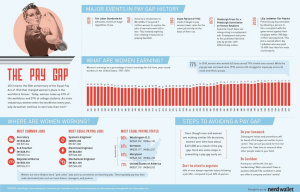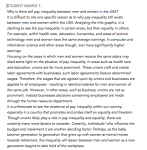Unit Objective
Having read a newspaper article (in English) and looked at an infographic overview of pay inequity in the USA, which discusses a Spanish law which mandates married couples divide household chores equally, students will compare and contrast gender roles in Spain and the US in a short paper (no more than one page single spaced, in English, with minimal errors), in which students must 1) discuss more than one perspective on the topic, 2) explain his/her own view on the topic 3) support own view (based on experience, anecdotal information, and/or other sources), 4) and maintain a respectful tone throughout.
Background and Rationale
A. The key concepts for the lesson:
- Household chores & gender roles
- Gender roles in the US and in Spain
- Pay inequity & gender roles in the US
B. Building on and connecting with previous lessons:
- Students have learned Spanish vocabulary related to household chores
- Students have discussed household chores in the target language
- Students have written a paragraph in the target language in which they compare the household chores performed by their parents as children, and by themselves as children.
C. Building on this lesson in subsequent lessons:
- Students will discuss the topic within the discussion board forum
- Students will respond to at least two peers’ posts about gender roles
D. Differentiated Activities:
- Students with fine-motor skill issues, which makes typing difficult, can record their assignment and submit as a mp3 file, or similar
- Students with visual impairments can use screen reader software to listen to peers’ comments and use similar speech to text software to participate within the discussion board.
Lesson Objectives
Objective |
Bloom’s Verb |
|---|---|
| Engage in critical thinking | Analyze |
| Compare and contrast cultural norms | Analyze & Evaluate |
Bloom’s Taxonomy
Analyzing
Common Core / State and District Standards
- American Council on the Teaching of Foreign Languages (ACTFL) Standard 2.2: Students demonstrate an understanding of the relationship between the products and perspectives of the culture studied.
- American Council on the Teaching of Foreign Languages (ACTFL) Standard 3.2: Students acquire information and recognize the distinctive viewpoints that are only available through the foreign language and its cultures.
- American Council on the Teaching of Foreign Languages (ACTFL) Standard 4.2: Students demonstrate under- standing of the concept of culture through comparisons of the cultures studied and their own.
Technology Integration (ISTE) Standards
- 4.c. Collect and analyze data to identify solutions and/or make informed decisions
- 4.d. Use multiple processes and diverse perspectives to explore alternative solutions
- 5.a. Digital citizenship – Students understand human and societal issues related to technology and practice legal and ethical behavior.
- 5.b. Exhibit a positive attitude toward using technology that supports collaboration, learning, and productivity
Lesson – Introduction
1. Students will be required to read one online article from the British Newspaper the Guardian, which looks at a marriage law enacted in Spain which requires the equal division of household labour:
Lesson Activities and Procedures
Student Procedure |
Teacher Procedure |
Materials |
|---|---|---|
| Students will look at an infographic, which looks at the gender pay gap | The teacher will provide the link to the infrographic | |
| Students will then read a study by Princeton University, which looks at gender bias in orchestra auditions: | ||
| Students are then asked answer the following question: Can we assume from the article about Spain’s marriage laws that Spain is more progressive in terms of gender equality than the US? | The teacher will provide other subquestions to be answered:
They are given five sub-questions to think about: 1. What do you notice about the title of the Guardian article? 2. Can we legislate in order to create more gender equality? 3. What does the article about the female musicians auditioning tell use? 4. Would you say Spain has more or less gender equality than the US? 5. Why is there no difference in pay between men and women in some jobs (like education and healthcare) and a large difference in other jobs (like business and engineering)? |
List of Questions |
| After submitting their answer to dropbox, students will then post a comment related to the topic in discussions. | Students are limited to five sentences in their post. Students are required to respond to at least two peer posts. |
Lesson – Closure
After the lesson I post two links in discussions to two funny videos related to pay inequity for students to watch:







